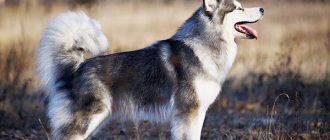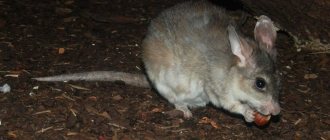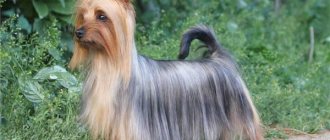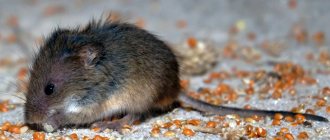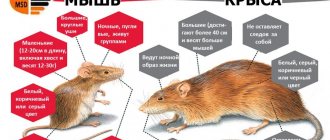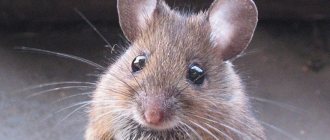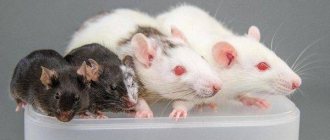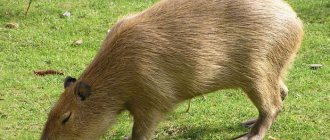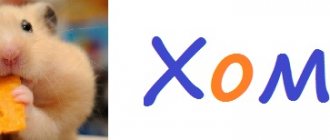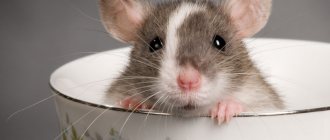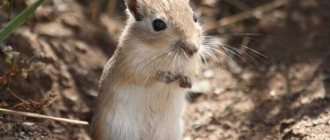Keeping decorative rats at home
Despite the compact size of the pet, this does not mean that you can neglect caring for your decorative rat.
Like any pet, a domestic rat needs a certain diet, a place to live, and it is also worth considering the presence of other pets before getting a pet. When purchasing a rat, you need to immediately think about where it will live. The only correct answer is a cell. For one individual, the size of the cage must be at least 30*50*40 cm; if the number of animals is larger, then the size of the dwelling increases. Interestingly, it is better for males to choose wider cages, and for girls - higher ones.
Do not load the cage with multi-story structures in the hope that the rat will find it more interesting. It’s better to build hammocks inside, put a couple of ladders, a wheel or a swing. The cage must have bedding: for example, made from sawdust (not pine wood!), you can also use corn or wood litter for cats or a special one for rodents.
As a budget option, you can take white paper, but not newspapers - rodents can be poisoned by toxic paint! The cage in which the animals live should be regularly removed, cleaned and the filler changed as necessary.
A prerequisite for proper maintenance of decorative rats at home is regular walking. While walking, remember a few important rules:
- put all valuable small items out of reach;
- many domestic rats like to chew and damage wires, so make sure that chargers, headphones and other equipment components are not left unattended;
- Make sure that all small animals are out of the animal's reach. Thus, these rodents are capable of attacking smaller rodents of other families, are able to climb into aquariums, and show aggression towards smaller animals.
dog
Important! Males and females must live exclusively in separate cells, otherwise uncontrolled reproduction and numerous offspring are guaranteed! Animals of different sexes also need to be walked at different times.
diet
- vegetables (zucchini, pumpkin, beets, zucchini, carrots, cucumbers, bell peppers);
- greens (basil, cilantro, onion, parsley, lettuce, celery, dill);
- fruits and berries (apricots, pineapples, cherries, melons, strawberries, apples, plums, peaches);
- combined grain feed (millet, barley, oats, buckwheat, rice);
- gammarus, seafood (boiled);
- dairy products (cottage cheese, kefir, fermented baked milk, yogurt, cream);
- meat products (rabbit, poultry), including offal, but only in boiled form;
- chicken eggs and fish (boiled).
So, what is forbidden to feed a decorative rat:
sausage and other prepared meat products (they contain a lot of spices and additives);
lard and deli meats;
from dairy products you should avoid sour cream, butter and condensed milk
Regular milk should be given with caution, as there may be intolerance to it; It is better to remove the seeds from fruits and vegetables. They are difficult to digest and may contain substances harmful to the animal;
citrus fruits are prohibited in the diet of rodents;
some fruits should be given with caution and not overdo it: bananas, grapes, avocados, pears, kiwi
Some of them are too high in calories, while others contribute to gas formation;
dried fruits should be supplied in very limited quantities;
beans, beans and peas strongly stimulate gas formation, so they should be excluded from the diet;
among vegetables you should avoid turnips, radishes and cabbage of all types;
potatoes must first be thermally treated;
It is strictly forbidden to give store-bought sweets, jam, honey, and baked goods.
Did you know? Rodents have teeth that grow throughout their lives, so they urgently need to regularly grind them down on hard and tough objects.
- if the animal is old and cannot fully care for itself;
- if the rodent is very dirty;
- if you haven’t cleaned the house for a long time, and the rat didn’t take care of itself carefully enough;
- if the animal has parasites that need to be removed.
What to feed a mouse
Ornamental mice feed mainly on grain mixtures, including seeds of herbaceous plants such as wheat, oats, peas, barley, cake, millet, sunflower seeds, and flax. Can be supplemented with nuts.
Oilseeds should be present in an amount of no more than twenty percent of the mixture in summer and thirty in winter, otherwise the risk of obesity is high. Too much legume seeds can also lead to obesity, although their presence in the diet is desirable. Mice can be pampered with berries, fruits, especially apples, dried fruits, carrots, cabbage, potatoes, beets and cucumbers. In addition to all of the above, feeding mice porridge is common. Oatmeal, rice and millet porridge are suitable. It is important that the porridge is cool and contains grains that have been previously cleared of impurities.
IMPORTANT You should not give mice chocolate, spicy, smoked, salty, sweet or fatty foods. This can cause them various digestive disorders and, in some cases, death.
It is vital for mice to have their incisors ground down from time to time . Small branches of trees and shrubs are well suited for this purpose, the main thing is that they contain bark. Almost all plants are suitable for this, except lilacs and conifers.
IMPORTANT Lilac is poisonous to ornamental mice.
If preparing food yourself is difficult, then pet stores sell ready-made mixtures and other nutritional components for mice.
Diseases
Like all animals, mice can get sick. Basically, all diseases of ornamental mice arise from improper maintenance. For example, due to low humidity in the environment, a mouse can develop tail ring syndrome, where ring-shaped sores appear on the tail. Therefore, it is better to keep the cage where the humidity levels are 50-55%.
Mice also suffer from pneumonia, salmonellosis, which, by the way, can be transmitted to humans, mousepox, otitis media and many other diseases, and some of them, unfortunately, cannot be treated. It often happens that a mouse dies within two days during illness. Not all diseases can be seen by symptoms, but some symptoms need to be known because they are not typical for a healthy mouse, namely:
- weight loss;
- ulcers on the body;
- frequent urination;
- blood in stool;
- partial baldness.
It is important to monitor the animal’s living conditions and immediately contact a veterinarian if any of the above symptoms are detected.
Breeds of decorative mice
The active work of breeders allows us today the opportunity to choose a pet of different breeds. Micromys minutus is considered the most popular among tailed babies. Mice of this breed reach a length of 7 cm, the tail is usually the same length.
Since at a young age the fur coat of these mice is not too thick, the babies do not look very attractive, but as soon as they grow up a little (in about a month), these pets are transformed. The mice's fur becomes thick and the color takes on a rich, bright orange hue.
Among the popular varieties of decorative mice are also spiny rodents. These animals got their name because of the unique structure of their fur. Quite long hairs grow on the back of babies, which resemble needles in shape. An elongated muzzle, large shiny eyes and an unusual ear shape make representatives of this breed bright and memorable.
Gerbils are also a well-known breed of mouse that is very popular among rodent lovers. These animals resemble small chipmunks due to their large body size and small drooping tail.
How much does a mouse weigh?
At birth, pups weigh 1-2g, body length 3cm. On days 4-5 after birth, their weight doubles. After weaning, the animals grow quite quickly, and at the age of one month their weight is 11-12 g. Mice are approximately 6-10cm long. Weight and linear parameters in mice finally stabilize at 6 - 7 months. By this time they weigh approximately 25-30g. The body weight of adult mice can vary depending on nutrition and housing conditions. The maximum weight of the mouse is 50g.
Features of behavior
Decorative mice are an ideal pet for those people who cannot spend a lot of time at home and pay a lot of attention to them. These rodents are completely unpretentious in care, that is, you don’t need to walk with them, there is no need for education and training, they don’t need a lot of space - they live perfectly within the confines of their own cage.
It is very interesting to watch them - each mouse has its own character and its own manner of behavior, which manifests itself in games and in interaction with a person or with relatives. Mice are quite active creatures. They love to play and also easily adapt to new conditions, such as moving to a different house or cage. Despite the fact that they are nocturnal, they are quiet and do not disturb anyone.
It is rare for mice to bite their owners, but this can happen due to fundamentally improper handling of the animal. If you are bitten, you must get vaccinated and change your behavior towards the mouse.
Maintenance and care
Keeping a decorative mouse is much easier in terms of allocating space than, say, a dog. They spend all their time in cages, and the space they occupy is limited only by the generosity of the owner. Although an acceptable area is considered to be at least twenty, and preferably twenty-five square centimeters, you can choose a pet cage of truly enormous sizes, it is only important to take into account the key details.
The cage should be made entirely of iron, or any other material that the mouse will not be able to chew through. Plastic and wood are not suitable.
The floor of the cage should be covered with shavings or sawdust. It is better to place the feeder and drinking bowl in places where they can be conveniently taken out for cleaning, which should preferably be done every day. You also need to remove any debris every day and, if necessary, renew the floor covering. An important point will be to provide the pet with a house and other infrastructure, for example, a running wheel or all kinds of stairs and pipes. Cage occupants will likely enjoy any additions to an empty cage, but owners should keep their pets' safety in mind. Unreliable structures, as well as structures with sharp parts, can threaten their health. It is better to place the cage away from windows to avoid drafts.
Types of decorative mice
Numerous varieties of Decorative mice differ in the type of coat and variations in color and color patterns. Different countries have their own national standards for varieties of Decorative Mice, which are used by judges during exhibitions and shows.
Short-haired mice
The hair of such a mouse is smooth to the touch, short and dense. The coat has a natural shine and lies close to the body, including the belly, groin, area around the front legs, and behind the ears. This type of coat is basic for all colors and patterns. Any of them is most easily recognized and looks brighter on the short-haired skin of a decorative mouse.
Satin Satin Mice
The name of the Satin Satin Mouse speaks for itself. Its coat has an increased shine, reminiscent of the smoothness of metal or satin fabric. The hairline shimmers in bright light. This effect is achieved due to the fact that the animal’s hair is empty inside, so it reflects light better. The hair is thick, dense, soft and silky to the touch.
Similar hair is found in all other decorative mice - Short-haired, Long-haired, Rosette, Rex, Hairless, etc. The satin mouse is larger than the usual decorative house mouse; the tail, in relation to the length of the body, is slightly larger than that of its ordinary relatives. The body proportions are almost the same, the ears are small and neat, the eyes are bright and shiny. The satin mouse comes from Asia.
Decorative Rex mice
This mouse is also called Astrex. You can easily recognize the decorative Rex mouse by its wavy fur with dense curls that are distributed throughout the body. The animal's whiskers are twisted and curled. The Rex coat type is found in other varieties of Ornamental Mouse. The Rex coat type is represented in four varieties of mice: Shorthair Rex and Shorthair Satin Rex, Longhair Rex and Longhair Satin Rex.
The most popular are the long-haired satin Rex mice. Their hairs are hollow and curl easily. The color of the animals can be any.
Abyssinian rosette mice
The animals got their name because they have areas of fur where the hairs change the direction of growth and curl into a funnel, forming a rosette. The Abyssinian rosette mouse has one or more such areas on each side. The sockets have a clearly defined center point. The shape is smooth, rounded. The Abyssinian coat can be of any length, as well as color.
Long-haired Angora mice
The Angora has long, smooth hair. The hairs are silky. These representatives of the mouse family have long antennae. Most often, breeders choose long-haired satin mice, whose hair is both fluffy, long-haired and shiny. Angora colors come in a variety of colors.
Long-haired Texel mice
The Texel mouse is easily recognized by its long-haired, curly coat with curls all over its body. The animal's whiskers are also curled. The hairline contains guard hairs that protrude beyond the normal coat.
Hairless Fancy mouse
Hairless mice are completely hairless. These hairless animals have wrinkled skin. The mustache can be short and curly. Some individuals have no antennae at all, as well as no fur. Among the behavioral habits, breeders note slowness.
Hairless mice are often kept together with their furry relatives to keep the hairless animals warmer.
Fuzz downy mice
Fuzz downy mice got their name from the English. fuzz - fluff, fluff. They have curly fur, but differ from Rexes in that the curls are denser and steeper. The wool is similar to the skin of a young lamb. The length may vary. The hairs are sparse, short, guard hairs are absent. The fur is light and distributed unevenly over the body. This gives the impression that the animal is devoid of hair.
The tail is bare and covered with scales. The disadvantage of living together with Fuzz mice is the strong and specific smell, so the animals’ home must be cleaned regularly. Downy mice are a fairly new variety of Ornamental mice - a provisional standard (FMC) was approved in 2014.
Care: mouse by mouse, and cleaning on a schedule
In fact, the house mouse does not need any special care. But taking care of the cleanliness of the cell is the most important condition. And not only for the animal, but also for the owner. The life cycle of these rodents is so intense that the cage needs to be cleaned at least twice a week. Otherwise, you are guaranteed to have a mouse smell in your apartment.
Cage cleaner
By “cleaning the cage” we mean changing the bedding and wiping all objects in the cage with a special product or soapy water. If you take the trouble and purchase a cage with a retractable tray, the cleaning process will be greatly simplified and will not take much time.
Feeding
Domestic mice, like their wild relatives, are omnivores. But under natural conditions, the mouse age is short and is marked by various diseases. It is in your power to avoid trouble and make sure that your pet eats well, does not get sick and does not cause trouble throughout its mouse life.
The mouse eats
The main rule is the same as for humans: a balanced diet. For you this means a combination of dry and succulent food:
- Dry: grains and seeds, as well as bread, crackers, mixed feed. Mice also happily eat budgie formula and even dry cat and dog food;
- Juicy: apple pieces, sprouted grains, green beans, not very juicy herbs. It is useful to offer insects in the diet from time to time: flies, butterflies and even cockroaches;
- Supplementing with vitamins and minerals once a month will also not be superfluous.
But what you absolutely cannot do is feed rodents with leftover food from your own table: food additives, spices and excess salt can harm your pet. If only occasionally indulge in a piece of cheese or other natural product, but not as the main diet.
Communication
Get ready for the fact that mice are nocturnal creatures, which means that most of your waking hours they will sleep or hide in their house or nest of litter, and rustle at night. But even with this way of life, a mouse, like any living creature, needs communication. At the same time, a lonely mouse needs much more of it than a family of mice. If you devote too little time to a rodent, it will soon become gloomy, withdrawn, quickly run wild and will hide when a person appears.
Don't let the mouse run wild
To make your pet active and friendly, talk to him, sit him in your palm, and play more often. It won’t take much time and won’t require excessive effort, but the return will not be long in coming and will be like in that cartoon: you come home, and he is happy with you.
And remember - we are responsible for those we have tamed!
Diversity of the mouse family
Types of mice Animals are best adapted to any living conditions. Agile, agile in their movements, rodents can run quickly, jump, climb, penetrate through the narrowest holes, and if there is an obstacle in front of them, then sharp teeth are used. A description of a mouse would not be complete without mentioning that they are quite smart and cautious, but at the same time shameless, cunning and brave. Possessing an excellent sense of smell and hearing, they are able to quickly respond to danger.
Reproduction process
Within 3 months after birth, voles become sexually mature. In this case, only a few cubs are born, but an adult is capable of giving birth to about 12 cubs, which indicates the high fertility of rodents.
When the cubs are born, they still do not see anything, completely naked and helpless. During the first month, the female takes care of her offspring, after which the young individuals leave the nest of their parents. After this, they themselves begin to take care of their lives. In the photo below you can see what the cubs look like immediately after birth.
After giving birth, within a week and a half, the mouse is again ready for fertilization. As a rule, a vole becomes pregnant up to 4 times during a season.
Decorative rodents
Selection has provided hundreds of different subspecies of mammals that sing and “waltz,” differing in their specific coat tone.
When choosing an animal, give preference to the following breeds of domestic mice:
- A miniature Japanese mouse, no more than 5 cm long, whose white skin is decorated with black and brown spots. Friendly and clean, she is a supporter of the nocturnal lifestyle and gives birth to up to 7 cubs.
- Spiny mice with needles on their back. It is reddish-brown or blackish-red in color. There is a hump of fat on the neck. It has an elongated nose, bulging eyes, and oval ears. The active animal loves people and becomes attached to them.
- A striped African specimen with an interesting coloration of light and dark stripes. It does not emit a smell and likes to climb on vertical surfaces. The mouse is extremely cowardly. Sensing trouble, she pretends to be lifeless or jumps up to two meters high. Does not grow longer than 10 cm.
Description
Ornamental house rats are a domesticated form and subspecies of gray rats of the mouse family. The presence of this animal in people's lives has been observed since ancient times. There are now many new varieties of rats that have been developed. At first they were used only as experimental laboratory animals. But in modern times they began to be kept as “companion” animals.
Different types of decorative rats have different sizes, differ in the properties and color of their fur, body structure and behavior. Their peculiarity is that when even the slightest danger arises, they secrete a specific liquid that smells unpleasant and thereby scares away enemies.
The animal has thick and rather dense fur on its body.
The elongated rat face has a sharp shape, small rounded ears and small oblong eyes, which can have different colors: red, black or ruby, as well as different colors - one black and the other ruby or red. Animals with red and ruby eyes see slightly worse than rats with black eyes.
Their jaws also have special features: the upper and lower molars are closely adjacent to each other, forming dense rows. This structure allows the rat to chew food quickly and energetically.
Incisors, which do not have roots, are much longer than other teeth. They grow constantly and intensively, so the rat regularly grinds them down so that he can close his mouth. Between the incisors there is an area without teeth.
All of its teeth are unusually strong and sharp; rats bite painfully and can easily gnaw through any hard surface (brick, hard metal, concrete).
Their tail is very long: its length is either equal to or much longer than the length of the body, with the exception of the species of short-tailed rats. In almost all varieties it has no fur, but has single bristles and is covered with characteristic scales.
In nature, a rat lives either in a large community, or forming a family clan, or isolated alone. For their homes, they choose burrows left by other animals, abandoned bird nests, natural shelters, or various buildings where they rest and sleep.
Rats have a highly developed sense of smell and hearing, which compensate for their insufficient vision. They do not live long: in the wild, up to about 1.5 years. Their lifespan often depends on the type of rat. Decorative pet rats live a little longer - up to about 2 years, and with good care they can live about 4 years.
Domestic rats, along with common features with wild species, also have differences. First of all, they differ in disposition: they have less aggressive, more calm behavior. Pets react calmly to bright light. Unlike wild rats, domestic rats do not have such a pronounced tendency to be nocturnal, and in conflicts with other animals they make sounds, but not so sharply.
General characteristics of the mouse family
Science knows 519 species of rodents from the mouse family. All of them perfectly adapt to different climatic conditions, lead a similar lifestyle and have a number of identical external characteristics.
Mice can be easily distinguished from other rodents by the following parameters:
- small head with a blunt or elongated muzzle;
- large, round or barely distinguishable ears;
- small beady eyes;
- small pink nose;
- stretched body;
- thin tail, the length of which is 70-120% of the body;
- small hands of the front paws;
- hind limbs with an outstretched foot, due to which mice can jump and rise up with emphasis on their paws;
- long sharp incisors, which are located in the center of both jaws and grow throughout the life of the animals by 2 mm per day;
- hard wool, the color of which depends on the type of mouse.
The average body size of a rodent is 9 cm, and the largest mouse is considered to be an individual whose body length reaches 13 cm.
In the natural environment, many species of mice are nocturnal. Their sleep alternates with waking phases from 25 minutes to 1.5 hours. Mobile, nimble rodents move along certain routes, which can be tracked by the droppings they leave behind. The average speed of the animals reaches 13 km/h.
In the wild, mice live in small groups that consist of one male, several females and their offspring. Grown-up cubs, as a rule, are expelled from the hole.
In their natural environment, rodents hide in tree hollows, earthen burrows or grass nests. Indoors, these animals live between walls, in attics and in the underground.
The diet of most mice includes small invertebrates, foliage, flowers and plant seeds. Sometimes the animals feed on bird eggs, worms, insects and small chicks. Rodents that live in houses eat any food, and also chew soap, candles, paper and even plastic products.
All types of mice are very fertile. The female is capable of bringing up to 5 litters a year, each of which contains 8-12 pups. The pregnancy of these animals lasts on average 25 days. Until three weeks of age, the pups feed on their mother's milk, and then begin to feed themselves. After 3 months, the grown rodents are already capable of procreation.
Many species of mice cause considerable harm to people. And the most dangerous thing is that rodents are capable of transmitting the following serious diseases to humans:
- tularemia;
- rabies;
- salmonellosis;
- leptospirosis;
- Bubonic plague;
- intestinal infections;
- typhus.
Infection can occur through mouse bites, as well as through food and water contaminated by them. In addition, scientists do not reject the possibility that rodents transmit breast cancer.
What do bats eat?
Most bats feed on insects, but there are also absolute vegetarians among them, preferring pollen and plant nectar, as well as various fruits. There are also omnivorous bats that love both plant foods and small insects, and some large species even hunt fish and small birds. Bats are excellent hunters, largely due to their wonderful echolocation property, which we described above. Vampire bats stand apart in terms of nutrition, feeding exclusively on the blood of wild and domestic animals (however, they can also feast on human blood), hence the name.
General health problems
Tumors are common in mice; they are usually malignant and fatal. Signs: A visible lump or swelling accompanied by lethargy or weight loss. Most tumors can be removed with surgery but are more likely to come back.
Another serious and common disease in mice and other pet rodents is wet tail, a gastrointestinal disease caused by an overcrowding of bacteria in the digestive tract.
It can progress rapidly and lead to death if left untreated. Symptoms: diarrhea, lethargy, lack of appetite and difficulty walking. A veterinarian can treat this condition with antibiotics.
Kinds
The mouse subfamily includes about three hundred species, each of which is characterized by external and behavioral features. Despite significant differences, most species have a number of similar characteristics.
Types of mice, typical features, and brief characteristics of the species are given below.
African mice
Unlike most of their relatives, African mice, whose homeland is called Tunisia, are not synanthropic species and are practically not tamed.
The body length of such a mouse is no more than twelve centimeters. The color is interesting: light brown or sandy fur has several dark longitudinal stripes. Rodents do not have a pleasant odor, which sets them apart from representatives of most other species.
The typical habitat of African rodents are burrows dug in the sand or nests made in dry grass. Their food is cereals, fruits, insects, and larvae.
The natural lifespan is about four years, but in the wild rodents can live no more than a year, due to the large number of natural enemies.
Grass mice
Grass mice live on the African continent. The body size of representatives of this species ranges from ten to seventeen centimeters.
Rodents prefer to settle in humid environments, for example, along the banks of rivers and lakes. Grass mice can build houses on their own, using dry grass, fluff, and also occupy other people's homes.
Lesnaya
A distinctive feature of wood mice is a small spot on the chest that has a yellowish tint.
These rodents are common in areas with temperate climates. Rotten stumps, dry grass, tree roots, and other voids of natural origin can serve as housing for them. Wood mice feed on cereals, insects, and berries.
Yellow-throated mouse
The yellow-necked mouse is classified as a poorly studied species listed in the Red Book.
The decline in the population of this species is due to the specific habitat; these tiny rodents, whose body length is no more than ten centimeters, live exclusively in deciduous forests.
Gerbil
The gerbil mouse fully lives up to its name, as it lives in hot deserts, semi-deserts, and steppes.
This breed of mice is distinguished by the presence of a long fluffy tail, which tends to fall off when in danger. A new one does not grow back. The diet of gerbils consists of cereals, insects, seeds, fruits, and nuts.
Gerbils can jump long distances and move on their hind legs. These rodents lead an active lifestyle during the daytime. In winter they do not hibernate, but become lethargic and inactive.
Gerbils are light brown in color, with the fur on their bellies being several shades lighter.
Harvest mouse
The field mouse lives in areas with temperate climatic conditions. The shades of the rodent's fur can vary from light brown to black; there is a longitudinal contrasting stripe on the back.
The body size of the animal is no more than ten centimeters. Mice of this species can live in urban areas. Their food sources are cereals, invertebrates, insects, fruits, and nuts.
House mouse
House mice are called synanthropic species of rodents that live close to human habitation, feed on food supplies, and prefer to spend the winter in houses and apartments.
The size of the rodent varies from eight to five centimeters. They are unpretentious to external conditions and nutrition. Life expectancy is about two years, but in good conditions the rodent can live up to four years.
Shrew
The shrew is a type of mouse that digs and also has a long, thin nose. The coat color of these animals is uniform and can vary from gray to black.
Shrews feel especially good near natural bodies of water.
Harm from voles
Farms, summer cottages and various agricultural organizations bear the brunt of the damage. They are massively engaged in the production of fruits, vegetables and other things. These are the places where mice are found most often.
These little rodents' teeth grow throughout their short lives, so they have a constant need to chew on something to wear down their teeth. Because of this, they gnaw the bark of trees, their roots sticking out of the ground, after which the tree becomes sick and rots. If they get into the house, they can even chew through the boards in the floors and walls, turning your house or warehouse into Swiss cheese.
Once in cellars or warehouses in winter, the mouse will eat everything there until spring, because it is very fertile for its short life.
Therefore, voles must be destroyed immediately as soon as their presence is noticed, otherwise the consequences can be dire.
But mice also bring significant benefits to people. Cosmetologists and doctors have been using mice for centuries to conduct all kinds of experiments. This is due to the extraordinary fertility of rodents and the similarity of the human and mouse genomes.
What does it eat?
Domestic mice are rodents, and the basis of their diet should be grains (wheat, millet, barley, rye, etc.). You can also give fruits, berries, vegetables and seeds of wild plants. You can offer your pets sunflower seeds and crackers as treats, but only in small quantities.
Wheat
When thinking through the diet, it is necessary to take into account that mice need to be given additional vitamin and mineral supplements.
You can also feed your pet ready-made food, which contains all the necessary ingredients for a balanced diet.
It is necessary to provide the rodent with branches of garden trees or birch trees for grinding down teeth. Even if you give your pet succulent food, make sure that there is always clean drinking water in the drinking bowl. The domestic white mouse especially needs liquid: even one day spent without water will seriously affect the pet’s well-being.
Varieties
There are different breeds of decorative mice. These include:
Micromys minutus (translated as “little mouse”) is the smallest mammal in Europe. The size of this rodent reaches 13 centimeters, and the tail and body are approximately the same length. The color of the back - from red to brown - is clearly distinguished from the color of the abdomen - white or light gray. They have a very mobile and grasping tail. The muzzle of these rodents, unlike their relatives, is shortened.
Gerbils. The second most popular breed, after baby mice. They are very similar to chipmunks because they have a body large enough for mice and a short drooping tail.
Spiny rodents. These mice look a little like hedgehogs. This is all because of their fur - it is shaped like needles. This breed is difficult to confuse with others, mainly because of the coat, but not only because of it. These mice also have very unusual ears and large black shiny eyes that look like beads.
Features of caring for decorative rats
Rats do not require too much space; they only need a small cage with ladders of various shapes, a house, a hammock, a wheel, where they can run or play with any other accessories.
They are also particularly unpretentious in nutrition and are considered omnivores. However, as for the correct diet, it definitely must be present, since the rodent needs all the useful substances and microelements for good health and excellent mood. It is enough to feed rats twice a day, morning and evening. At night the portion should be larger.
This is due to the fact that these creatures are nocturnal inhabitants. The diet must contain grains, cereals, vegetables, fruits, and dairy products. Don't forget to regularly change the water in the drinking bowl so that your pet doesn't suffer from thirst.
The main disadvantage of these cute creatures is their short lifespan. In general, rats do not live longer than three years, and this applies to absolutely all breeds. Therefore, an important piece of advice when you buy a pet is to choose a rat that is no more than one and a half months old.
With proper care, any breed of domestic decorative rat you like will always delight you and your child with excellent health and good mood.
Contents: every mouse has its own hole
Each animal needs its own special space, which it will consider “its place” - sacred and inviolable. Therefore, before you bring mice home, you should take care of where they will live. It was before, not after. Because jars and cardboard boxes are absolutely not suitable for rodents. And any move is always stressful.
Avoid aquariums as well. They are cramped, stuffy, hot, the mouse will not be able to move normally in them and arrange a secluded corner for itself. The best solution would be a spacious cage with metal bars.
Rodent cage
Be sure to make it yourself or buy a small house - a hole where the mouse will spend all day long.
Add a wheel to provide your pet with physical activity and fulfill his need for movement. For the same purpose, take care of shelves, ladders and ropes. The animal will be happy to show you its dexterity, and you will also have fun watching its amusing movements.
Sawdust for rodents
Litter is a very important element. The layer should be quite impressive - at least 5 mm. Animals use it not only for its intended purpose, but also to decorate their house, and when there are drafts or low temperatures, they burrow into it to keep warm.
The material should be natural and preferably inexpensive: sawdust, dry peat crumbs, shavings, hay. Avoid cotton wool and sand - the first absorbs odors too well and gets tangled between your fingers, and the second can become a breeding ground for lice. But something tells us that you don’t want such neighbors.
average life expectancy
How many years mice live depends on environmental conditions, dietary habits, and a number of other factors. The average lifespan of mice in the wild is about three years.
Factors that reduce the population size and life expectancy of individuals include natural enemies, infectious diseases, abnormally high or low temperatures, and poor nutrition.
For example, the lifespan of decorative mice, regardless of the size of the individual, is about six years. This is easy to explain - animals kept as pets receive a sufficient amount of food and elements important for the body.
They also do not suffer from adverse weather conditions, are protected from predators and most diseases.
Distribution of the house mouse
The homeland of the house mouse is northern India or northern Africa or Western Asia; in all these regions the species is known in fossil form. Later, together with people, the house mouse spread throughout the world and today it is a cosmopolitan animal.
House mice do not live only in the Far North, Antarctica and in the mountains at high altitudes. Their prevalence is somewhat limited by low air temperature and high humidity. In Russia, house mice do not live in the northeast of Siberia, on the Taimyr Peninsula, near the Yenisei and Lena, in the mountain tundra.
The number of house mice varies with the seasons; at the end of winter it is smallest, and with the beginning of spring and the breeding season, the number of individuals grows and reaches its maximum in autumn.
